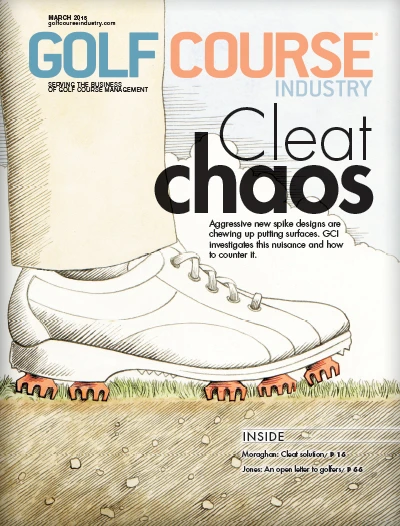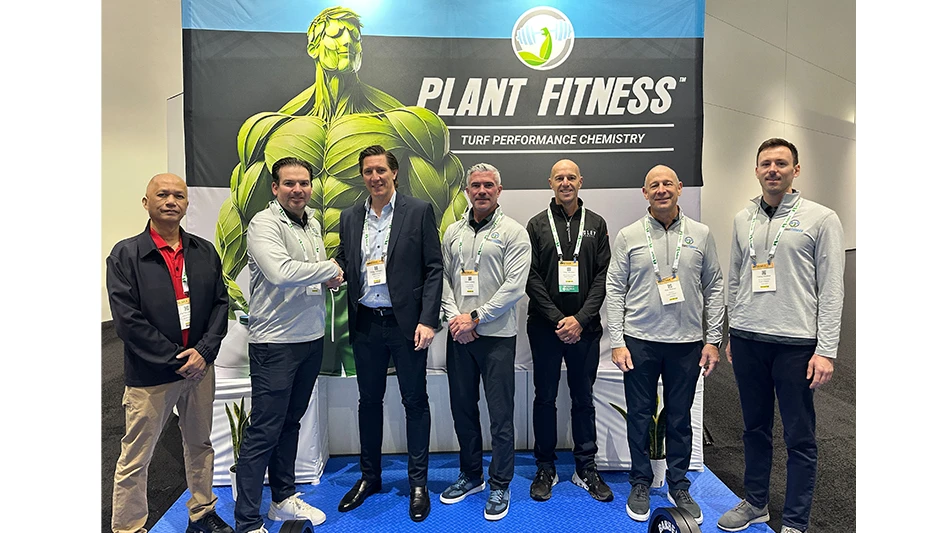 While little is known about the annual bluegrass weevil, this tiny pest is making plenty of noise in the Northeast, and slowly making its way to other parts of the country.
While little is known about the annual bluegrass weevil, this tiny pest is making plenty of noise in the Northeast, and slowly making its way to other parts of the country.
According to Albrecht M. Koppenhöfer, professor and extension specialist in the Department of Entomology at Rutgers University, the annual bluegrass weevil (ABW) is in the Curculionidae family within the insect order of the beetles (Coleoptera). Weevils generally have an elongated snout and contain the largest number of species of any known family of anything living.
Museum records show the ABW is found throughout much of the continental United States and southern parts of Canada, but next to nothing is known about it outside of the golf course habitat, Koppenhöfer says.
It is supposed to be semi-aquatic which would explain its preference for wetter areas on golf courses, he says. Yet, as a problem on golf courses, it was first reported in the New York City metropolitan area in the 1930s and has been slowly spreading out from there like an introduced pest. It is now causing problems on golf courses from southern Quebec and southern Ontario south to Maryland and west to eastern Ohio. There are also at least two isolated problem areas in eastern Virginia and in the foothills of North Carolina, Koppenhöfer adds. “Maybe the insect adapted to the golf course habitat in the NYC met area, and this ‘golf course strain’ has been spreading from there,” he says.
The ABW’s method of spreading is another question mark. It can fly but is not very good at it, Koppenhöfer says. It may be spread on infested turf, which might explain such isolated populations as in eastern Virginia and western North Carolina. “Golf courses that don’t have this insect, yet, should be extremely careful to accept sod from other golf courses that already have this insect,” he says.
 Air temperatures are used to estimate movement, though soil temperatures may be better predictors. However, tracking soil temperatures in relation to ABW activity is a fairly recent activity, says Benjamin McGraw, associate professor of turfgrass science at Penn State University, although he can’t say for certain. He adds sudden freezes following a warm period only cause the insect to become suspended in its activity.
Air temperatures are used to estimate movement, though soil temperatures may be better predictors. However, tracking soil temperatures in relation to ABW activity is a fairly recent activity, says Benjamin McGraw, associate professor of turfgrass science at Penn State University, although he can’t say for certain. He adds sudden freezes following a warm period only cause the insect to become suspended in its activity.
“[It] doesn’t kill them,” McGraw says. “They are well suited for being exposed to cold temperatures. The adult overwinters a few centimeters in the soil, so I am sure that they can handle it.”
Cold periods during the spring migration period will slow down the ABW to the short mown areas, but adults already on the short mown areas tend to “hunker down,” Koppenhöfer says. This results in apparent dips in the number of adults found when monitoring, but it does not affect their survival.
Spraying earlier is not necessary as the adults have not started to lay eggs, yet, Koppenhöfer says. Earlier spray, he adds, will only increase the chances of resistance development for three reasons: people will tend to apply another adulticide a couple weeks later; they unnecessarily kill beneficial insects including predators of ABW, and they result in sub-lethal insecticide concentrations when the majority of adults will appear on the short-mown areas.
As for knowing when the ABW has arrived at your course, McGraw says an early warning sign would be to look for the initial yellowing of the turf caused by larval feeding, but even then it might be too late. It would be better to look for adults prior to that.
“I would look for adults in mower baskets, especially from greens and collars where they are easily removed,” he says. “Look for larvae by taking triangular sections of turf and dipping them in a saturated saline solution to extract even the youngest stages.”
|
WeevilTrak Update Syngenta announced upgrades to its WeevilTrak (weeviltrak.com) platform. The key to a successful annual bluegrass weevil control program is proper decision-making on the timing of treatments early in the season. WeevilTrak alerts registered users on the optimum time to control weevils.
|
Managing the spring generation is crucial because it sets the tone for the rest of the season, Koppenhöfer says. Use plants as phenological indicators.
“Because both ABW and plants depend on the environmental conditions (especially temperature) for their development, certain plants just happen to be in certain conspicuous stages when the ABW is doing certain things,” he says. “When using indicator plants, one cannot rely on just a single or few plants, but has to look at the bigger picture. Plants should be used that are close to the areas of interest and are not in unusually warm or cool conditions.
“One can also use Growing Degree Day accumulation to predict ABW activity,” Koppenhöfer adds. “This is most commonly done using a base temperature of 50 F (10 C) starting March 1.”
According to Koppenhöfer, the most important phenological indicators are:
- When forsythias are in full bloom, the overwintered adult ABW migrate to the short-mown playing surface. Do not apply adulticides at this time. Toward the end of this period, monitoring for adult ABW should be started to estimate if and where adulticides (i.e., insecticides targeting the adults) need to be applied;
- Around the time when forsythia are about half gold/half green, adult ABW reach peak densities on the short-mown areas. This is the best time to determine adult densities and with that, the need for applications. In areas where adult ABW densities are too high, an adulticide should be applied at this time. This time corresponds to about 110-125 GDD50. Effective adulticides for non-resistant populations include pyrethroids and chlorpyrifos. Against resistant populations, chlorpyrifos may still work, but lower levels of resistance to this compound have already been observed;
- When flowering dogwood and eastern redbud are in full bloom, ABW egg-laying has begun. After this, adulticides become less effective as they do not kill the eggs. About one week after onset of full bloom dogwood is the time when systemic compounds should be applied that target the early ABW larval stages feeding inside the grass stems. This time corresponds to about 175 GDD50. Effective systemic compounds for non-resistant ABW include Acelepryn and Ference. Against resistant population, Ference may still work, but the database for its efficacy versus resistant ABW is very limited; and
- When Catawba Rhododendron hybrids are in full bloom, ABW larvae start to come out of the plants to feed externally on the grass crowns. This is the time when one can start monitoring for larvae in the soil and start to apply larvicides targeting the larvae in the soil where their numbers are high. This time corresponds to about 350 GDD50. Effective systemic compounds for non-resistant ABW include Conserve, Provaunt and Dylox. Against resistant ABW, only Conserve may be effective.
Eradication is not possible, Koppenhöfer says. Superintendents who try this only end up with “glow-in-the-dark” insecticide-resistant ABW, he says in jest. The best and most sustainable way to manage ABW is to keep the annual bluegrass populations on the playing surfaces as low as possible wherever possible.
“ABW prefer annual bluegrass as a host plant and annual bluegrass is a lot more susceptible to it than creeping bentgrass,” he says. “ABW can also infest and develop on creeping bentgrass, but it may take three to four times higher ABW larval densities to cause damage. And bentgrasses may look bad for some time, but usually recover. Annual bluegrass gets wiped out.
“The thing with ABW is that it is a pest that people have to learn to live with and manage it by practicing true integrated pest management (IPM),” Koppenhöfer says. “Trying to control it with excessive insecticide applications seems to inevitably lead to resistance, and broad resistance at that. At that point, ABW becomes a nightmare.”
|
One super’s fight Superintendent Chris Carson, Echo Lake Country Club in Westfield, N.J., is a leader in ABW control. For nearly a quarter-century, Carson has dealt with ABW and still only considers it a nuisance. “He has been doing what I preach people to do: Minimize insecticide applications in space and time and keep Poa annua populations as low as possible wherever possible,” says Albrecht M. Koppenhöfer, professor and extension specialist in the Department of Entomology at Rutgers University. According to Carson, the first sighting came at the cost of half of his 16th green in June of 1988 - “a horrible weather year,” he says. Having never heard of hyperodes weevil, a colleague from Westchester County consulted. Summer patch had also been wreaking havoc on greens that season. “Since then, we have treated preventively once per season for adults on greens and a few approaches and fairway spots only,” Carson says. “We have used a combination of triplex mowing, collecting clippings and other cultural methods to naturally convert our fairways and approaches to mostly bentgrass. “At times, ABW has hit us in places,” he adds. “We've spot-treated or let the infestation run its course, thinning out Poa and letting bent fill in. The key is to scout and treat promptly for us to avoid turf loss.” Other than a once-per-year preventive treatment for adults, spot treating collars when he sees ABW is about all he does now – knowing exactly when and where to look first. Understanding what the loss of grass – especially on greens – means, Carson is fully aware of the panic that can overcome a superintendent battling ABW. “The instinct becomes to prevent and treat widely and often,” he says. “As it relates to ABW, though, this instinct has ramifications that, in the long run, can make things very much worse. Sort of a downward spiral, or inescapable whirlpool.” If your course is in a region affected by ABW but have yet to see any damage, resist the urge to begin the battle. “I wouldn’t recommend treating unless you know you have it and have sustained some damage in the past,” says Benjamin McGraw, associate professor of turfgrass science at Penn State University. “Sounds harsh to some, but why treat unless it is a problem? Finding ABW doesn’t always translate into damage. I would recommend focusing on growing the healthiest turf possible.” |
Rob Thomas is a Cleveland-based writer and frequent GCI contributor.

Explore the March 2015 Issue
Check out more from this issue and find your next story to read.
Latest from Golf Course Industry
- The cost of golf: How much is too much?
- Is Vietnam the planet’s fastest-growing golf country?
- Husqvarna rolls out new robotic mowers
- Envu appoints new board chair
- Calusa Country Club opens in Florida
- Tapatio Springs taps Troon for course management
- Nagle plans renovation of Toftrees
- From the publisher’s pen: How did the show go?





